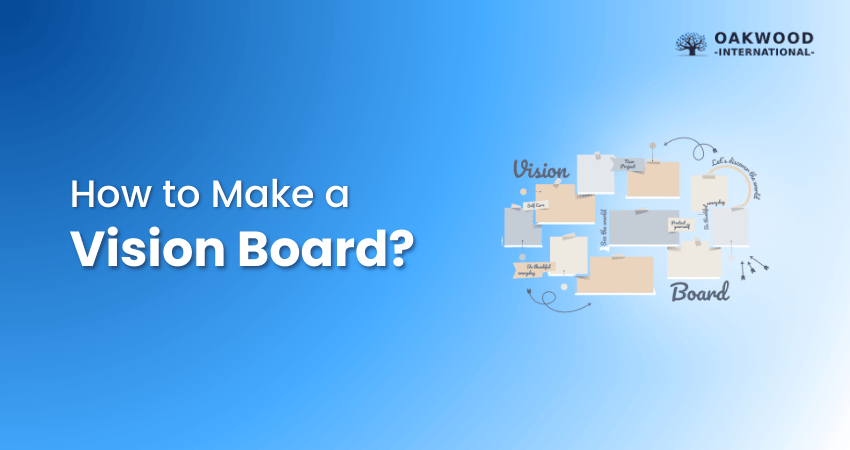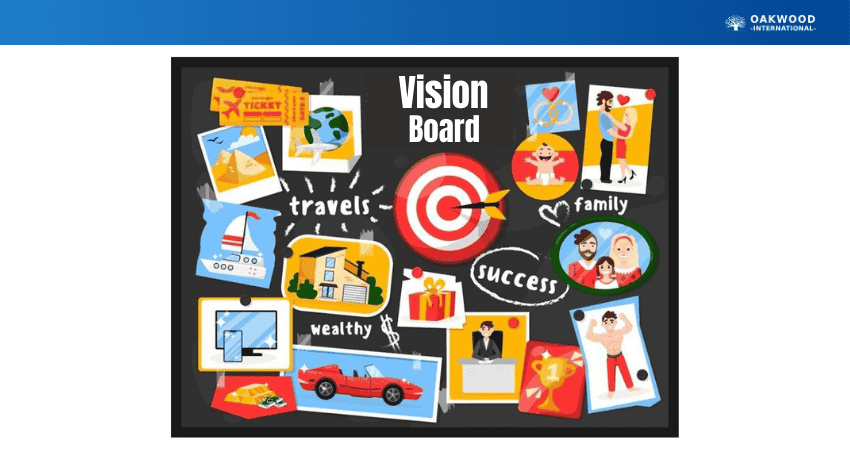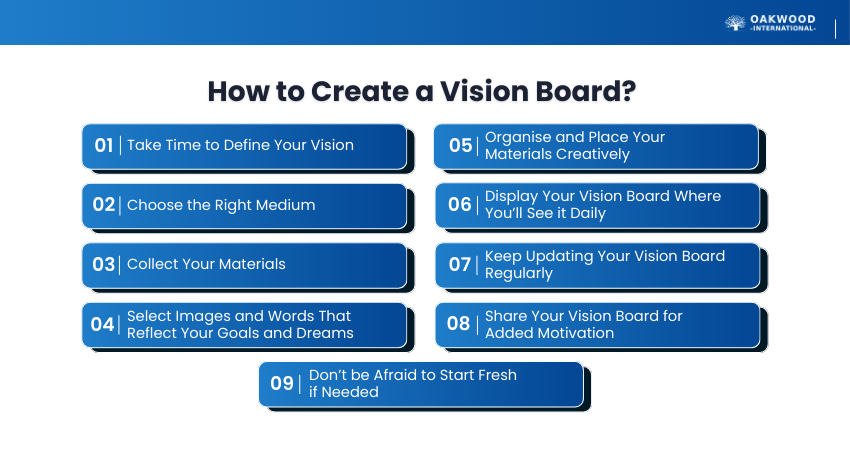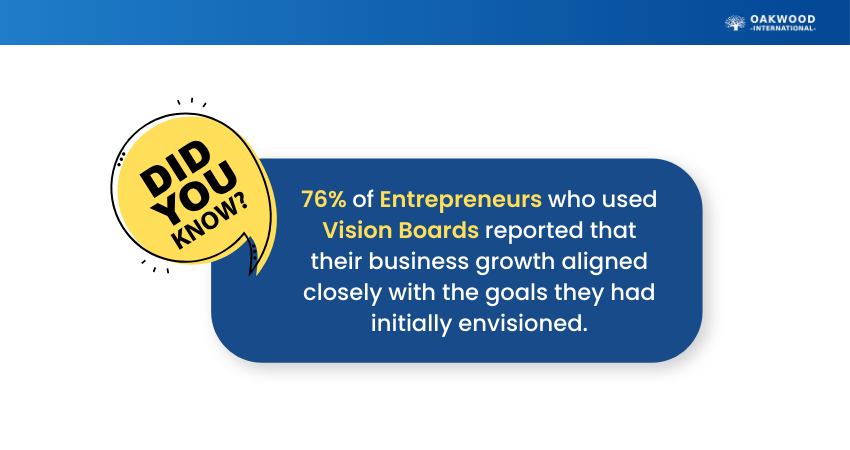Table of Contents


Your goals deserve more than a fleeting thought. They deserve space to shine. Too often, we set goals in our minds, but we get caught up in busy schedules or a lack of direction. But what if there was a simple, creative way to give your goals the attention they truly deserve?
That’s what Vision Boards are capable of. They are powerful, visual reminders of what you’re working toward. You can turn your “someday” into real, achievable steps. Curious to know how? Read on this blog on How to Make a Vision Board and start creating one for yourself!
Table of Contents
1) What is a Vision Board?
2) Ideas to Include in Your Vision Board
3) How to Create a Vision Board?
4) Take Time to Define Your Vision
5) Choose the Right Medium
6) Collect Your Materials
7) Select Images and Words That Reflect Your Goals and Dreams
8) Organise and Place Your Materials Creatively
9) Display Your Vision Board Where You’ll See it Daily
10) Keep Updating Your Vision Board Regularly
11) Share Your Vision Board for Added Motivation
12) Don’t be Afraid to Start Fresh if Needed
2) Conclusion
What is a Vision Board?
A Vision Board is a collage of images, words, and symbols that acts as the visual representation of your goals and objectives. It is also known as a dream board or goal board. You can create a physical board using magazine clippings, drawings, and printed photos, or design a digital version.

It helps you clarify your desires and focus your energy. By looking at your board regularly, you reinforce your goals in your mind and start recognising opportunities that align with them. This technique is often used in manifestation, personal development, and goal-setting practices.
Ideas to Include in Your Vision Board
Before diving into the creation process, it’s helpful to brainstorm the kind of content you might want to include. Here are some categories and ideas:
1) Activities you want to do more of, like travel, fitness, or creative hobbies
2) People who represent the qualities or lifestyle you want to attract
3) Quotes, lyrics, or affirmations that motivate and align with your goals
4) Words or images that reflect your core values and life purpose
5) Meaningful items you want to own, such as a car for freedom or a home for comfort
6) Colours that represent emotions you want to feel, like calm, joy, or energy
7) Places you dream of visiting and add their postcards, maps, or scenery
8) Skills or knowledge you wish to gain, like learning, creating, or growing
9) Loved ones or relationships you want to cherish or strengthen
10) Things you’re grateful for and want to keep in your life
How to Create a Vision Board?
Creating a Vision Board is a fun, creative, and deeply personal process. There’s no right way to do it since it is personal to everyone. So, let’s check How to Make a Vision Board for your goals:

1) Take Time to Define Your Vision
Before you begin gathering materials, take a moment to reflect on what you truly want in life. Ask yourself:
1) What goals matter to me the most right now?
2) Where do I want to be in one year, five years, or ten years?
3) What values drive my choices?
Instead of writing “I want success,” try to be more specific, like “I want to grow my online business to earn £5,000/month by next year.”
2) Choose the Right Medium
Your Vision Board can be physical, digital or portable. It depends on your lifestyle and preferences.
Physical Boards:
1) Poster board, cork board, canvas, foam board, or even recycled cardboard
2) Pinboard, magnetic board, whiteboard
3) Customise with fabric, stickers, paint, or washi tape
Digital Vision Boards:
1) Use tools like Canva, Google Slides, or Pinterest
2) Great for portability and easy updates
3) Can be saved as your wallpaper
Portable Options:
Scrapbooks, journals, three-ring binders, or photo albums
1) Handy for those who travel or want to keep their board private
2) Choose what excites you. Whether it is a tangible board you can hang or a digital one you can revisit often, go with the format you’ll enjoy using and updating.
3) Collect Your Materials
Start collecting images, words, and items that represent your goals. You can use what you already have or visit a craft store or second-hand shop for inexpensive supplies. Sources can include:
1) Old magazines, brochures, or catalogues
2) Printed quotes, digital photos, or Pinterest pins
3) Personal photos, postcards, tickets, or drawings
4) Small items like ribbons, pressed flowers, fabric, or stickers
Make a lasting impact on people and performance with our CIPD Level 5 Associate Diploma in Organisational Learning and Development – Register today!
4) Select Images and Words That Reflect Your Goals and Dreams
This step is where your vision starts coming to life. Find visuals that resonate emotionally with your goals and the future. Words carry power, so feel free to write your own quotes or use those that inspire your mindset.
Here are some ideas for that:
1) Travel destinations for future adventures
2) Dream homes, vehicles, or career-related objects
3) Fitness inspiration or health-related visuals
4) Photos of family, friends, or role models
5) Affirmations like “I am confident,” “I attract success,” or “Joy flows into my life”
5) Organise and Place Your Materials Creatively
Once you’ve collected your images and words, it is time to assemble them. Don’t stress about making it perfect because this should be fun and inspiring. Here are some layout ideas:
Grid Layout: Divide the board into categories like career, relationships, travel, etc.
Free-flowing Design: Let your creativity lead without structure
Central Theme: Place your core goal or word in the centre, building outward from it
Your board doesn’t need to follow any design rules. What matters most is that you connect with it emotionally and visually.
6) Display Your Vision Board Where You’ll See it Daily
Your Vision Board needs to be visible to work its magic. The more often you see it, the more it stays in your mind, influencing your thoughts and actions. So, make it part of your daily life, something you glance at every morning or reflect on while journaling or meditating.

Ideas for placement:
1) On your bedroom wall or wardrobe door
2) Beside your desk or in your workspace
3) On your fridge, next to the mirror, or across from your bed
4) As a desktop background or phone lock screen (for digital boards)
Drive real change in people practices with our CIPD Level 5 Associate Diploma in People Management – Join soon!
7) Keep Updating Your Vision Board Regularly
Your goals will grow and change, and that is a good thing. To maintain consistency, you need to revisit your board every few months to:
1) Remove goals you’ve achieved or outgrown
2) Add new dreams and affirmations
3) Refresh the layout or design to stay inspired
8) Share Your Vision Board for Added Motivation
You don’t have to share your board with everyone, but telling someone you trust can add accountability and support. You could:
Share photos of your Vision Board in a vision board group or on social media
Discuss your goals with a friend over coffee
Host a “Vision Board night” with your team, friends, or family
9) Don’t be Afraid to Start Fresh if Needed
Sometimes, your paths shift drastically. A new job opportunity, a life event, or even a shift in mindset may prompt a full refresh. In such cases, you don’t have to hesitate to create a new Vision Board.
Making a new board is a sign of growth. It means you're realigning with your values and stepping into the next chapter of your life with intention.
Conclusion
A Vision Board is a personal roadmap to your dreams. By visualising your goals and surrounding yourself with meaningful imagery and words, you’re giving your dreams a place to grow. If you know How to Make a Vision Board, this task can be done easily and reflect who you are becoming. So, gather your ideas and tap into your creativity. Your dreams are waiting; give them space to shine.
Boost your confidence and career prospects with our CIPD Qualification – Explore now!


 Back
Back



 Back to Catagories
Back to Catagories





 + 44 7452 122728
+ 44 7452 122728










